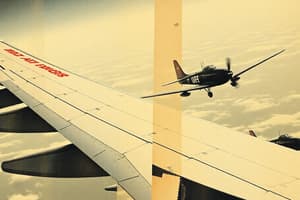Podcast
Questions and Answers
What is one purpose of wing flaps?
What is one purpose of wing flaps?
- To decrease wing area to vary the lift.
- To enable the pilot to make steeper approaches to a landing without increasing the airspeed. (correct)
- To relieve the pilot of maintaining continuous pressure on the controls.
One of the main functions of flaps during approach and landing is to
One of the main functions of flaps during approach and landing is to
- increase the angle of descent without increasing the airspeed. (correct)
- permit a touchdown at a higher indicated airspeed.
- decrease the angle of descent without increasing the airspeed.
What is the purpose of the rudder on an airplane?
What is the purpose of the rudder on an airplane?
- To control overbanking tendency.
- To control roll.
- To control yaw. (correct)
Which is not a primary flight control surface?
Which is not a primary flight control surface?
Which statement is true concerning primary flight controls?
Which statement is true concerning primary flight controls?
Which device is a secondary flight control?
Which device is a secondary flight control?
The four forces acting on an airplane in flight are
The four forces acting on an airplane in flight are
When are the four forces that act on an airplane in equilibrium?
When are the four forces that act on an airplane in equilibrium?
The term "angle of attack" is defined as the angle between the
The term "angle of attack" is defined as the angle between the
The angle of attack at which an airplane wing stalls will
The angle of attack at which an airplane wing stalls will
What force makes an airplane turn?
What force makes an airplane turn?
An airplane said to be inherently stable will
An airplane said to be inherently stable will
In the Northern Hemisphere, a magnetic compass will normally indicate a turn toward the north if
In the Northern Hemisphere, a magnetic compass will normally indicate a turn toward the north if
During flight, when are the indications of a magnetic compass accurate?
During flight, when are the indications of a magnetic compass accurate?
Which instrument will become inoperative if the pitot tube becomes clogged?
Which instrument will become inoperative if the pitot tube becomes clogged?
Which instrument(s) will become inoperative if the static vents become clogged?
Which instrument(s) will become inoperative if the static vents become clogged?
What does the red line on an airspeed indicator represent?
What does the red line on an airspeed indicator represent?
What is density altitude?
What is density altitude?
What is pressure altitude?
What is pressure altitude?
Under what condition is pressure altitude and density altitude the same value?
Under what condition is pressure altitude and density altitude the same value?
What action can a pilot take to aid in cooling an engine that is overheating during a climb?
What action can a pilot take to aid in cooling an engine that is overheating during a climb?
If the grade of fuel used in an aircraft engine is lower than specified for the engine, it will most likely cause
If the grade of fuel used in an aircraft engine is lower than specified for the engine, it will most likely cause
What type fuel can be substituted for an aircraft if the recommended octane is not available?
What type fuel can be substituted for an aircraft if the recommended octane is not available?
Filling the fuel tanks after the last flight of the day is considered a good operating procedure because this will
Filling the fuel tanks after the last flight of the day is considered a good operating procedure because this will
Flashcards
What is the purpose of wing flaps during landing?
What is the purpose of wing flaps during landing?
Wing flaps increase the wing camber and angle of attack, increasing lift and induced drag, allowing for steeper descents without increasing airspeed.
What is the purpose of the rudder on an airplane?
What is the purpose of the rudder on an airplane?
The rudder controls yaw, which is rotation around the vertical axis of the airplane.
What are the primary flight controls in an airplane?
What are the primary flight controls in an airplane?
Primary flight controls include ailerons, elevator (or stabilator), and rudder.
What are spoilers in aviation?
What are spoilers in aviation?
Signup and view all the flashcards
What are the four forces acting on an airplane?
What are the four forces acting on an airplane?
Signup and view all the flashcards
What is the angle of attack in aviation?
What is the angle of attack in aviation?
Signup and view all the flashcards
At what angle of attack does a wing stall?
At what angle of attack does a wing stall?
Signup and view all the flashcards
What force makes an airplane turn?
What force makes an airplane turn?
Signup and view all the flashcards
What does it mean for an airplane to be inherently stable?
What does it mean for an airplane to be inherently stable?
Signup and view all the flashcards
When will a magnetic compass indicate a turn toward the north?
When will a magnetic compass indicate a turn toward the north?
Signup and view all the flashcards
Which instrument becomes inoperative if the pitot tube is clogged?
Which instrument becomes inoperative if the pitot tube is clogged?
Signup and view all the flashcards
Which instrument(s) become inoperative if the static vents are clogged?
Which instrument(s) become inoperative if the static vents are clogged?
Signup and view all the flashcards
What does the red line on the airspeed indicator represent?
What does the red line on the airspeed indicator represent?
Signup and view all the flashcards
What is density altitude?
What is density altitude?
Signup and view all the flashcards
What is pressure altitude?
What is pressure altitude?
Signup and view all the flashcards
When are pressure altitude and density altitude the same?
When are pressure altitude and density altitude the same?
Signup and view all the flashcards
What action can be taken to cool an overheating engine during a climb?
What action can be taken to cool an overheating engine during a climb?
Signup and view all the flashcards
What happens if lower than recommended fuel is used in an aircraft engine?
What happens if lower than recommended fuel is used in an aircraft engine?
Signup and view all the flashcards
What fuel can be substituted if the recommended octane is not available?
What fuel can be substituted if the recommended octane is not available?
Signup and view all the flashcards
Why is it good practice to fill fuel tanks after the last flight?
Why is it good practice to fill fuel tanks after the last flight?
Signup and view all the flashcards
What do ailerons control?
What do ailerons control?
Signup and view all the flashcards
What does the elevator control?
What does the elevator control?
Signup and view all the flashcards
What are trim tabs used for?
What are trim tabs used for?
Signup and view all the flashcards
What does the stabilator do?
What does the stabilator do?
Signup and view all the flashcards
What does the vertical component of lift do?
What does the vertical component of lift do?
Signup and view all the flashcards
What is centrifugal force in aviation?
What is centrifugal force in aviation?
Signup and view all the flashcards
Study Notes
Wing Flaps
- One purpose of wing flaps is to enable the pilot to make steeper approaches to landing without increasing airspeed.
- Another purpose of wing flaps is to relieve the pilot from maintaining continuous pressure on the controls.
- Wing flaps increase wing camber and angle of attack, enabling steeper approaches to landing.
- Trim tabs, not wing flaps, help relieve control pressures.
- Wing area usually remains the same, except for specialized flaps increasing wing area.
Flaps During Approach and Landing
- Flaps increase lift and induced drag, enabling the pilot to decrease the angle of descent without increasing the airspeed.
- Flaps increase lift at slow airspeeds, allowing for touchdown at a lower indicated airspeed.
Rudder Purpose
- The rudder controls yaw, which is rotation about the airplane's vertical axis.
- Ailerons (not the rudder) control overbanking tendency in steep turns.
- Ailerons correct for the tendency of outside wings to travel faster and lift more, opposing overbanking tendency.
- Roll is movement around the longitudinal axis and is controlled by ailerons.
Primary Flight Control Surfaces
- The three primary flight control surfaces are the ailerons, the elevator, and the rudder.
- Flaps are not a primary flight control surface.
- The stabilator or elevator is a primary flight control surface.
- Ailerons are also a primary flight control surface.
Airplane Aerodynamics
- The four forces acting on an airplane in flight are lift, weight, thrust, and drag.
- Lift opposes weight.
- Thrust opposes drag.
- Lift is produced by wings opposing weight.
- Thrust is generated by the engine/propeller.
- Drag results from air resistance as the airplane moves.
Angle of Attack
- Angle of attack is the angle between the wing's chord line and the relative wind.
- The chord line is a straight line from leading edge to trailing edge.
- Relative wind is the direction of airflow relative to the wing.
- Angle of attack is not dependent on the airplane's longitudinal axis.
- The angle of attack at which an airplane wing stalls remains the same regardless of gross weight.
Airplane Turn
- The horizontal component of lift causes an airplane to turn.
- The vertical component of lift opposes weight and controls vertical, not horizontal movement.
- Centrifugal force is not part of the turning force.
- Inherently stable aircraft are easier to control than inherently unstable aircraft.
Compass Turning Error
- In the Northern Hemisphere, a magnetic compass will normally indicate a turn toward the north if an airplane is accelerating while on an east or west heading.
- Compass readings are accurate in straight-and-level, unaccelerated flight.
- The compass will not be accurate during turns.
Pitot-Static System
- Airspeed indicator is inoperative if the pitot tube is clogged.
- Altimeter and vertical speed indicator will be inoperative if the static vents are clogged.
- The pitot system is part of the airspeed indicator.
- The static system is part of the altimeter and vertical speed indicator.
Airspeed Indicator
- The red line represents the never-exceed speed (the highest speed).
- Maneuvering speed and turbulent speed are not directly indicated on the airspeed indicator.
Density Altitude
- Density altitude is the pressure altitude corrected for non-standard temperature.
- Density altitude is the same as pressure altitude at standard temperature.
Engine Overheating
- To aid in cooling an engine that is overheating during a climb, reduce the rate of climb and increase airspeed.
Abnormal Combustion
- Use of lower fuel grade for an airplane engine will most likely cause detonation.
Aviation Fuel
- Substitutions for aircraft fuel should use higher octane if recommended octane is unavailable.
Studying That Suits You
Use AI to generate personalized quizzes and flashcards to suit your learning preferences.




